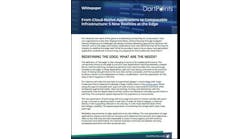DCF Roundtable: Managing Through the Capacity Crunch
What's ahead in the data center sector for 2023? How will data center developers navigate a challenging environment and deploy capacity to meet the demand for more cloud capacity?
That’s our subject as we kick off our quarterly Data Center Frontier Executive Roundtable, which features the insights of six thought leaders on the state of the data center industry. Our Fourth Quarter 2022 roundtable will explore several other relevant topics:
Here’s a look at our distinguished panel:
- Peter Panfil, Vice President of Global Power at Vertiv.
- Shannon Hulbert, the Chief Executive Officer of cloud specialist Opus Interactive.
- Phillip Marangella, Chief Marketing Officer at EdgeConneX.
- Frank Nash, the Vice President of Technical Sales and Solutions in Schneider Electric’s Data Center Solutions organization.
- Steven Lim, Senior Vice President, Marketing and Product at NTT Global Data Centers Americas.
- Eric Boonstra is General Manager & Vice President Europe at Iron Mountain Data Centers.
Each day this week I’ll moderate a Q&A with these executives on one of our key topics. We begin with our panel’s take on the outlook for data center deployment in 2023.
Data Center Frontier: What will delivery timetables for new data center capacity look like in 2023? Will the combo of supply chain issues, power constraints and staff shortages have an impact on supply?
Peter Panfil, Vertiv: There are many variables that go into data center deployment timetables, but the short answer is that supply chain delays are likely to continue into 2023. All of the issues you mention will have an impact.
There are parts of the world where power limitations are real and can slow or stall new data center construction – sometimes due to government intervention. Staffing is an ongoing issue for our industry and something we are likely to grapple with for years as we adjust to the well-earned retirement of the Baby Boomer generation and new technologies exacerbating a growing skills gap.
The supply chain disruption will prompt change across the industry, with data center organizations working urgently to diversify their supply chains. In practice, that means pursuing in-region suppliers and expertise in the interest of speed while simultaneously leaning on global suppliers with scale who can provide more certainty in terms of product availability. These efforts will continue in 2023 and may extend to investments in new capabilities and acquisitions to facilitate the ability to secure critical components.
Some have already placed their equipment buys for 2023, 2024 and beyond. These advanced purchases are more than just getting an earlier spot in line – they help infrastructure equipment suppliers focus their supply chains on what is specifically needed and when, versus buying from a generic planning bill. This improves the likelihood of schedule surety.
All of these issues will accelerate one of the dominant trends in our industry today – the move toward prefabricated modular designs and solutions. This doesn’t eliminate supply chain delays, but it can allow organizations to compress construction timelines by manufacturing systems and components offsite, while site prep is under way. It also can streamline the design phase of most projects by introducing an element of repeatability into the proceedings.
Frank Nash, Schneider Electric: From the manufacturers’ perspective, we expect that delivery timetables for new data center capacity will vary widely across the broader service provider network. Service providers who foresaw the impact of supply change challenges early and moved quickly to secure supply through buying/capacity agreements will be in the best position to deliver new capacity most effectively.
The industry experienced a “perfect storm” in 2022 with a massive increase in demand, coupled with significant supply chain disruption, that has created a “Hunger Games” environment. We expect lead times to remain extended into 2023. However, based on an expected gradual recovery of the supply base, lead times should improve as the year progresses. Constrained supply in electronics (microchips) will continue until new semiconductor fab production capacity is brought online in the next few years.
Power constraints are already inhibiting delivery of new data center capacity, most notably in the Northern Virginia corridor. Utility capacity limitations coupled with extended large transformer lead times are expected to continue throughout 2023 and, in some regions, well into 2024.
Shortages in skilled labor, both in the contracting trades and in facility management, have been problematic even prior to COVID lockdowns. We expect labor shortages to slow delivery of new data center capacity in 2023. That said, more widespread deployment of prefabricated modular solutions that allow for offsite fabrication will help to mitigate the impact of trade labor shortages.
Today’s challenges may bring with them some near-term extensions in the capacity timeline, but in the long run they’ll make us a better, more nimble, more efficient industry.
Shortages on the labor market remain critical in delivering capacity on time and keeping the lights on in data centers. It's no secret to anyone who works in this industry that it can be challenging to deliver capacity on time while everybody is working extremely hard to meet customer demands, and we don’t see a significant change for 2023 as demand hasn’t slowed down.
Also sustainability in the supply chain is a greater factor than it ever was before, with more standards and regulations being implemented in 2023. We decided to build all our new facilities and expansions via the BREEAM sustainable building standard. But in Germany for example, starting January 1st 2023, the Supply Chain Diligence Act will come into play, which requires businesses to monitor their entire supply chains and report on partners causing environmental degradation. This might just be a first step as the EU is working on legislation that might go even further.
Steven Lim, NTT Global Data Centers: NTT GDC still has significant development plans both in the US and abroad to build and deliver a great deal of new capacity in multiple markets next year. The challenges in delivering this new capacity are not small, as supply chain delays have persisted for several years, and now power shortages are becoming real in many established markets.
At NTT, we are doing our best to mitigate these challenges with a focus on planning and engagement with our vendors — essentially creating a more robust supply chain with multiple suppliers that have to have a multi-faceted supply chain and multiple suppliers that can flex as needed.
Furthermore, managing long-term planning and project timelines is key to minimizing delays and supply chain constraints -- forecasting changes now, restructuring thought processes and planning processes, running projects in parallel and moving inventory across multiple projects to avoid delays.
Throughout this process, we also maintain a great deal of transparency with our clients about what’s happening so everyone has clear expectations and can plan properly from their perspective as well.
Shannon Hulbert of Opus Interactive: It's taken several quarters and factors for the industry to reach this point - geopolitical energy supply impacts, post- pandemic leveling out, supply chain, power constraints and the movement to hybrid and multi-cloud strategies. We’ll continue to see supply be impacted.
Also being tested is the strength of business models and service offerings. The industry is right-sizing itself and we’ll likely see a group of battle-tested services and organizations emerge on the other side of 2024.
NEXT: The state of Edge Computing as we enter 2023.
Keep pace with the fact-moving world of data centers and cloud computing by following us on Twitter and Facebook, connecting with DCF on LinkedIn, and signing up for our weekly newspaper using the form below:












